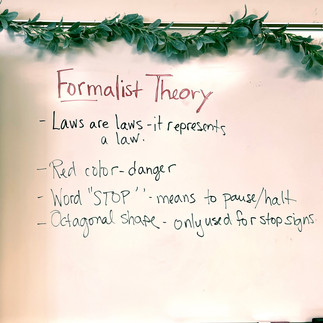Learning about and using theories of literary criticism can be intimidating for any student. We think it’s important for our students to read the rationale behind each theory and learn the key terms to use when reading through that lens, but we can see our students’ eyes growing heavy and their attention spans getting shorter when we begin with terms like “recursive reading” or “condensation.” Brittany and I wondered how we could introduce the concept of reading theory in a memorable and engaging way. And we came up with… a stop sign. Weird, I know, but stay with me here.
On the first day we introduce literary criticism to our students, we start with the image of a stop sign on the whiteboard or projector. We pose a hypothetical scenario:
“Imagine that, in 1000 years, all human beings are gone from Earth. What remains is a stop sign at the intersection of two streets. The question you must discuss: does the stop sign have any meaning?”
Students will have all sorts of answers, follow-up questions, and arguments. I keep track of their main points on the whiteboard in three separate lists:
Students who argue that the meaning of the sign comes from those who view it. These students may say the sign has no meaning because human beings are gone. They might add that future humans (or aliens) will return to earth and gain some meaning from it. They might also add that the sign means something different to other creatures (a spider building its web on the sign, a mouse with its nest at the base). These students have just discovered Reader Response Theory.
Students who argue that the sign has meaning because it represents the laws, civilization, and structure of the world from the past. To these students, the sign is an artifact that can help us gain knowledge about the world at a different time. They might also argue that the person who created the stop sign intended it to mean something. These students have just discovered New Historicism.
Finally, there will be students who argue that the stop sign’s meaning comes from the sign itself: its octagonal shape, its red color symbolizing danger, the four letters which mean “halt.” These students have just discovered Formalism.
I don’t add the names of these critical theories to the board until the end. It’s neat to surprise students by showing them that they already use and understand the lenses!

After this activity, students read and annotate some background information on Reader Response, Formalist, and New Historicist theories. Throughout the year, we add Psychoanalytic Theory, Feminist Theory, Queer Theory, and Sociological Theory, and we begin new texts that lend themselves to those lenses.
Typically, we allow our students to practice using a new lens on a short text of some sort. For the first three theories, we use Theodore Roethke’s poem, “My Papa’s Waltz.” When we introduce Psychoanalytic Theory, we start with a short animated film called "Spellbound," by Ying Wu and Lizzia Xu, and then we follow up with David Michael Kaplan’s short coming-of-age story, “Doe Season” (which is also perfect for Feminist Theory). Another rich collection of texts just waiting to be analyzed is Disney clips. We have our students choose and analyze their own to focus on messages about gender roles!
Teaching these critical theories helps us add structure and rigor to our language arts classes. It’s fascinating to hear the insights students come up with when they are reading through one of these lenses! If you use literary criticism in your class, how do you introduce it? Do you have any other short story or poetry suggestions? We’d love to learn from you!
-Jamie




Commenti